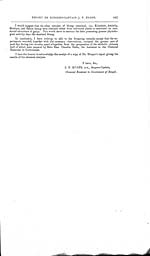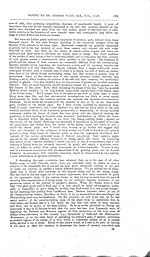Medicine - Drugs > Report of the Indian Hemp Drugs Commission, 1894-1895 > Volume III
(232) Volume 3, Page 228
Thumbnail gallery: Grid view | List view

228 REPORT OF THE INDIAN HEMP DRUGS COMMISSION, 1893-94. [APP.
REPORT BY DR. GEORGE
WATT, M.B., C.M., C.I.E., &c., REPORTER ON ECO-
NOMIC PRODUCTS TO THE GOVERNMENT OF INDIA.
In reply to your letter
No. 1969/181, dated 23rd April, and your unofficial reminder
to
hand, I have the honour to say that I had not intended to
contribute anything towards the
present enquiry into the subject of Indian hemp, because I have
little to add that would
likely be of any great value further than what is contained in my
previous publications
on that subject. Indeed, what I might be induced to say as to the
botany of Cannabis
sativa might fairly well be characterised as pure speculation,
since I have had no oppor-
tunity of personally confirming the impressions obtained from
casual observation. Since,
however, it seems to be the wish of the Government that I should
offer some remarks, I
may point out that while the forms of the plant met with in India
are botanically only
states of Cannabis sativa, I believe that, as with all other
cultivated plants, there are
recognisable races of that species. It would indeed be contrary to
experience in other
fields of study were it otherwise. The external differences between
these forms are however
very slight and such as the botanist is by universal usage
permitted to disregard. In the
herbarium they are indeed hardly distinguishable, though, from the
cultivator's point of view,
these slight differences may be indicative of widely dissimilar
properties. Few botanists
would venture to isolate aus, aman, boro, and rowa
races of Oryza sativa; yet the rice
cultivator of Bengal would have no difficulty in distinguishing
these and many others; nor in
fixing the period at which each should be sown and the nature of
the soil on which its
cultivation would be most successful. This, in my opinion, is an
exactly parallel case, and I
might mention many such to the wonderful problem of the production
of so widely different
products as bhang, ganja, charas, and hemp fibre from botanically
one and the same plant.
Some of the racial characteristics that exist may be mainly due to
climate and soil; but it
should not be forgotten that there are generally very potent
influences in the production of
races of cultivated plants. It would accordingly be most unwise to
set on one side the
possibility of differences, on the ground of these being mainly, or
even exclusively, due to
climatic and other such influences.
I hold, therefore, that
the study of the living plants on the part of a botanist
might
very possibly result in the isolation of the fibre-yielding plant
of Cannabis sativa as possessing
certain structural peculiarities more or less constantly associated
with that physiological
property, just as I believe that a similar isolation might be
possible in the bhang, ganja, and
charas-yielding states of the plant.
2. The practical bearings
of this purely botanical contention might be very extensive
and valuable. So far as I am aware, no botanist has as yet
explained the formation of the
narcotic in certain forms of Cannabis, and not (or
practically not) in others. We may, in
fact, be said to be ignorant of the precise use of that substance
in the economy of the
plant. Its discharge from the stems, leaves, flowers, and fruits
seems to a large extent
mechanical and to be dependent on some external disturbance, more
especially an inter-
ruption to the sexual functions of the individual. It may indeed be
said to be uncertain
whether the formation of the narcotic should be regarded as an
excretary substance normally
deposited within receptacles, or be viewed, in its early stage at
least, as a substance intimate-
ly connected with the metabolism of the plant, but which becomes a
useless bye-product of
life under certain conditions. But of course such excreta are only
useless to plant life, in
so far that they are not concerned in the further nutritive
processes which accompany growth.
This is important in its bearing on the probable chemical history
of the narcotic. The solid
and liquid contents of the laticiferous vessels, for example, of
the poppy or of the India
rubber plant are very different from the deposits found within
glands. The former bear a
distinct analogy to the blood in the veins of animals, while the
latter might not inaptly be
characterised as refuse matter. The contents of the laticiferous
vessels may, however, be
said to be of two chief kinds-(a) those which are constantly
being used up in the growth of
tissues, such as the proteids, carbo-hydrates, fats, and ferments;
and (b) the secretions and
excretions ultimately thrown down within these vessels or their
vesicular modifications, such
as the resins, gums, alkaloids, etc. Through the action of ferments
many of the latter
subsequently become available for the future growth of the plant,
so that they are more
properly stores of food than excreta. But the purely excretary
matter stored up by plants
in their variously formed receptacles may be here mentioned, such
as granules of calcium
oxulate; resins and ethereal oils combined usually into
balsam, mucus, various kinds of gums;
and lastly tannins (some tannins are, however, reserve-materials).
These and such like are
the excretary deposits, and they are made normally within
individual cells dispersed through
the tissue or into cells arranged in rows forming vesicles between
the vascular bundles.
Sometimes also the receptacles of secretion are intercellular
spaces of various shapes and
sizes filled by the discharges from the abutting cells A
well-marked modification of this
might be mentioned in the resin and gum passages which are formed
by the separation of
Set display mode to: Large image | Zoom image | Transcription
Images and transcriptions on this page, including medium image downloads, may be used under the Creative Commons Attribution 4.0 International Licence unless otherwise stated. ![]()
| India Papers > Medicine - Drugs > Report of the Indian Hemp Drugs Commission, 1894-1895 > Volume III > (232) Volume 3, Page 228 |
|---|
| Description | Volume 3: Appendices. Miscellaneous. |
|---|---|
| Attribution and copyright: |
|




